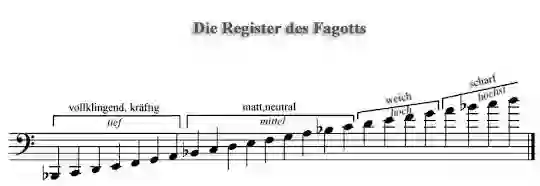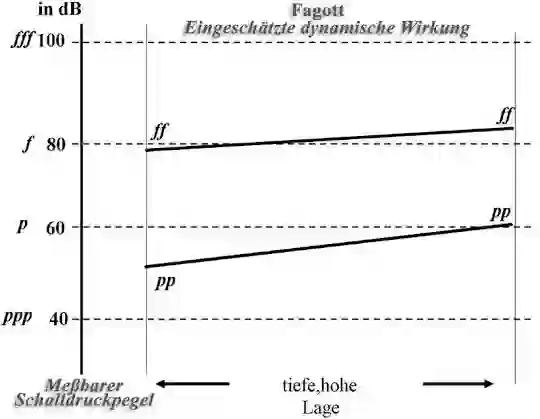Sound character of the Bassoon - Philipp Dangas
Register table of the bassoon
The sound of the bassoon in the hands of a good player is one of balanced, calm beauty. As a result of its structure, the bassoon lacks the characteristic piercing luster of the oboe. However, one of the main characteristics of the bassoon is its high ability to merge with almost all other instruments.
When performing thematic or contrapuntal tasks, the difference in sound between the bassoon and the oboe instruments must be taken into account. Extension of the oboe register in depth is only achievable through the use of English horn and heckelphone.
As part of the „symphonic world music“
The bassoon is one of the main instruments in the realization of the sound.
Table summary of the sound character of the Bassoon
The table below shows the registers and timbres of the bassoon briefly described. The highest register, the middle register and the deepest registers described.
Dynamic effect of the bassoon
Sheet music for the dynamic table from the bassoonThe following table shows the different degrees of musical dynamics. In addition to the sound pressure scale measured in decibels [dB], the degrees of strength of musical dynamics are given on the left, which can be understood as "objective" degrees.
One can clearly see a diagram, namely a diagram is drawn to the right of the dB scale. It shows the estimated dynamic effect over the entire tonal range of the instrument. The dynamic effect (volume) as judged (perceived) by the listener.
In the low register of the trumpet, for example, the dynamic range between pianissimo [pp] 46 decibels [dB] and fortissimo [ff] 82 decibels [dB] = 36 decibels [dB]. In the high register, the range is 8 decibels [dB]. The estimated values can deviate more or less from the "objective" ones.
Consequently, the deviations between the instruments are different. The mentioned "objective" levels of intensity piano pianissimo [ppp]= 40 decibels [dB], p=60 decibels [dB] etc. enable the composer to predict the dynamic effects of different instruments that are sounding simultaneously.
Table summary of the dynamic span of the bassoon
The following table shows the achievable dynamic span of the bassoon shown. The span is the difference between the fortissimo and the Pianissimo in the same pitch.

The register table of the bassoon in a large representation
- Highest register
- The sound can be described as sharp
- High register
- Light sounding but intense
- Middle register
- Matt and neutral sounding
- Lowest register
- Full-sounding and quite powerful

The dynamic table of the bassoon
Internal search function
| Name | Value | Delete |
|---|